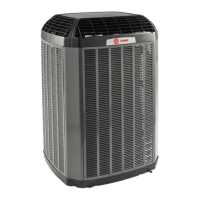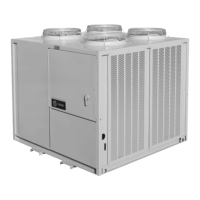DWG. NO. 4TWZ0024-SF-1C
ONLY DIPSWITCH
1 ON
ONLY DIPSWITCH
2 ON
ONLY DIPSWITCH
3 ON
SEE TABLE A
PAGE 2 *
SEE TABLE A
PAGE 2
SEE TABLE B
PAGE 2 **
55 192 199 210
60 206 213 227
65 221 229 245
70 238 246 264
75 256 264 284
80 275 284 306
85 295 305 329
90 316 327 354
95 339 350 380
100 363 374 407
105 388 400 435
110 415 427 465
115 443 456 497
120 471 485 529
125 502 516 563
PRINTED FROM D155859P01 REV 4
** Data is based on 18.0° of subcooling at a 95° ambient
2 TON HP R410A REFRIGERANT CHARGING CHART
Liquid
Tem
LIQUID GAGE PRESSURE (PSIG)
* Data is based on 9.5° of subcooling at a 95° ambient
3
WIRING DIAGRAM
MANUAL CHARGING OR CHARGE ASSIST
TM
METHOD IN
COOLING BETWEEN 55°F AND 120°F OD AMBIENT
It is recommended to install manufacturer approved matched indoor and
outdoor systems.
All approved split systems are ARI rated with only TXV indoor systems.
The benefits of installing approved indoor and outdoor split systems are
maxi mum efficiency, optimum performance and the best overall system
reliability. The following charging methods are therefore prescribed for
matched systems with indoor TXVs.
1. Subcooling using the R-410A Refrigerant Charging Chart (in the cooling
mode) is the only recommended method of charging between 55°F and
120°F ambient temperatures.
2. When charging for ambient temperatures above 120°F, charge to 10°
subcooling. It is important to return when outdoor ambient temperature
is between 55°F and 120°F to verify system charge per these instruc-
tions.
3. For best results – the indoor temperature should be kept between 70°F
to 80°F. Add system heat if needed.
4. At startup, or whenever charge is removed or added, the system must
be operated for a minimum twenty (20) minutes to stabilize before
accurate measurements can be made. (Feature of Charge Assist™)
5. Measure Liquid Line Temperature and Refrigerant Pressure at service
valves. (Not required with Charge Assist.™)
6. Determine total refrigerant line length, and height (lift) if indoor section is above the condenser. Set dip switches on Charge Assist™ board as
indicated in the Subcool Charging Corrections Table on page 2 .
7. Locate your liquid line temperature in the left column of the table, and the intersecting liquid line gage pressure under the DIPSWITCH selection
column. Add refrigerant to raise the pressure to match the table, or remove refrigerant to lower the pressure. For manual charging, always wait twen-
ty (20) minutes for the system conditions to stabilize before adjusting charge again. (Not required with Charge Assist.™)
8. Charge Assist port is designed for liquid refrigerant charging.
9. When system is correctly charged, you can refer to System Pressure Curves (on page 8) to verify typical performance.

